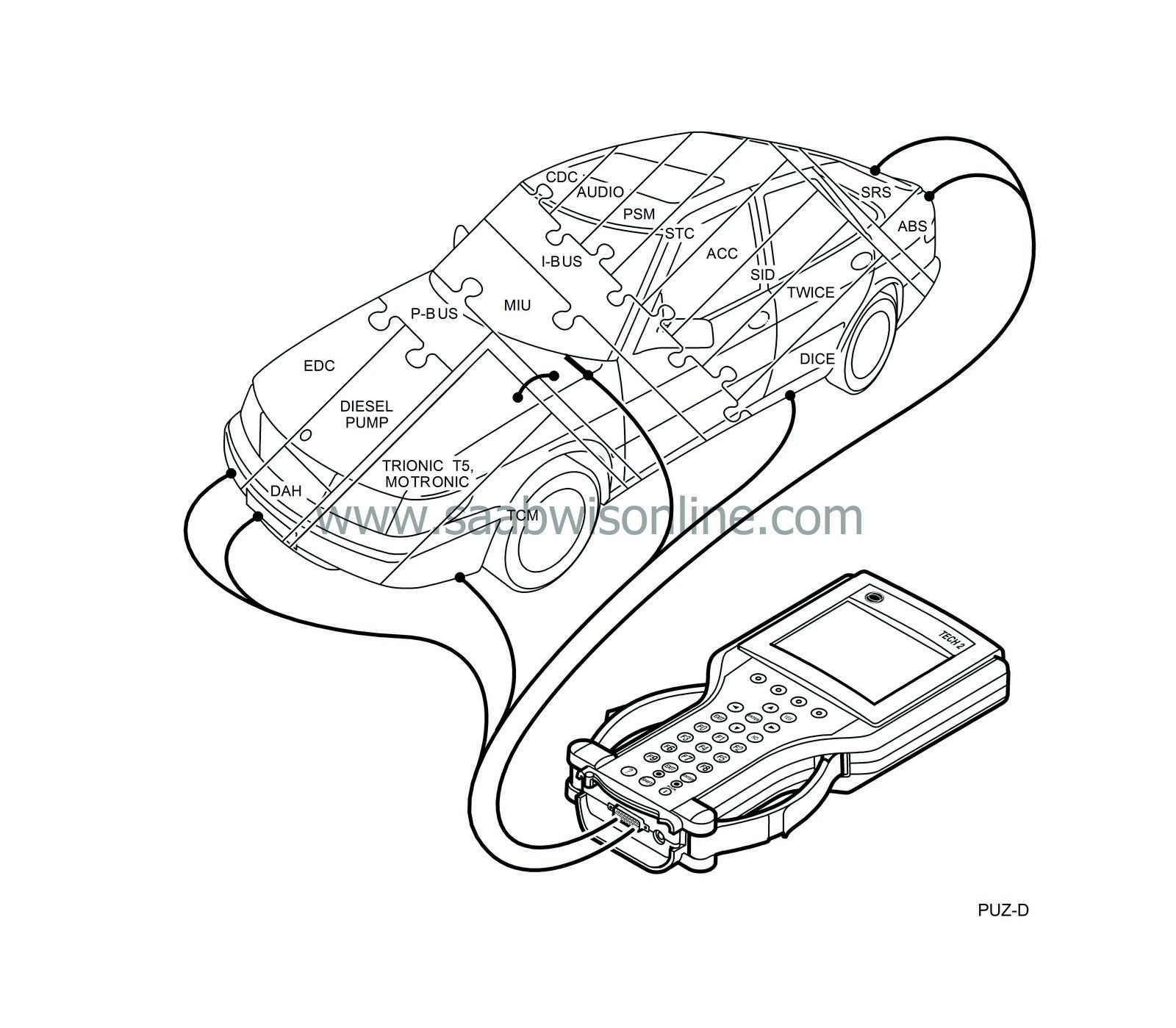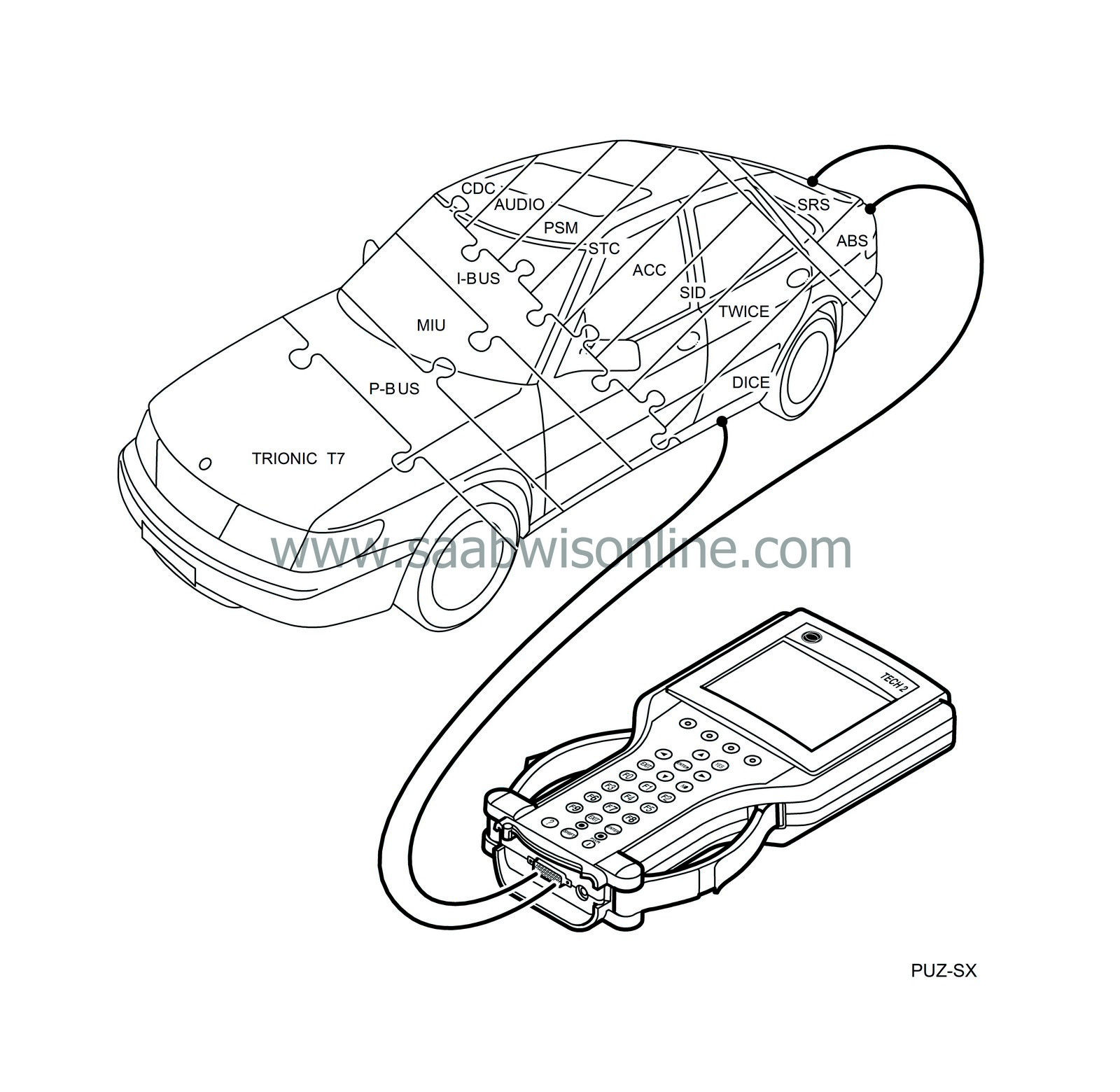Brief description of the main instrument unit
|
|
Brief description of the main instrument unit
|
The main instrument unit conveys information to the driver and functions as an information link between the P bus and the I bus.
The main instrument unit has its own diagnostics function and sets a diagnostic trouble code when a fault occurs.
The main instrument unit incorporates the following:
|
•
|
Coolant temperature gauge
|
|
•
|
Instrument and display lighting
|
|
•
|
Warning and indicator lamps
|
The main instrument unit receives information from its own sensors and also from other systems. The control module processes the information, which is used to control instruments and lamps. Certain information is put on the bus.
The car is fitted with an electronic speedometer, which displays the current speed. The rear left wheel sensor sends information on the speed to the ABS control module, which processes the information and sends it on to the main instrument unit.
The main instrument unit control module stores the driven distance and displays it on the odometer display. The display contains a six-digit register, which the control module continuously updates from 000000 to 999999 km (or miles). The tripmeter contains a four-digit register, which starts at 000.0 and runs to 999.9 km (or miles).
The electronic tachometer shows the current engine speed. It receives bus information on the engine speed continuously from EDC 15. The display of engine speeds below 1100 rpm is damped to give a more stable reading.
The fuel gauge gives the driver information on how much fuel is left in the tank. It consists of a fuel gauge in the main instrument unit and a level sensor in the tank.
With less than 10 litres of fuel in the tank, the main instrument unit's control module switches over to measure fuel consumption. Information is received on the bus from EDC 15. This gives a more accurate reading of the fuel level. The fuel reserve indicator lamp goes on when the fuel level is under 10 litres.
|
Coolant temperature gauge
|
The coolant temperature gauge gives the driver information on the engine coolant temperature. Information is received on the bus from EDC 15.
|
Warning and indicator lamps
|
The main instrument unit contains the following lamps:
|
•
|
Indicator lamp INFO DISPL, lights up when a message is shown on the SID unit.
|
|
•
|
Central warning lamp, lights up when a fault occurs in a system having to do with the car's safety.
|
|
•
|
Oil pressure warning lamp, warns the driver when engine oil pressure is too low.
|
|
•
|
Charge warning lamp, indicates to the driver whether or not the generator is charging.
|
|
•
|
AIRBAG warning lamp, warns the driver when a fault has occurred in the airbag system.
|
|
•
|
Brake fluid level warning lamp, warns the driver if the level in the brake fluid reservoir is too low or if there is a fault in the ABS system.
|
|
•
|
Handbrake warning lamp, indicates to the driver that the handbrake is on.
|
|
•
|
ABS warning lamp, the lamp lights up when there is a fault in the ABS system.
|
|
•
|
Fuel reserve indicator lamp, the lamp lights up when the fuel level is below 10 litres.
|
|
•
|
CHECK ENGINE indicator lamp, warns the driver that there is a fault in the engine management system.
|
|
•
|
Direction indicator repeater lamps, right and left. Show when the direction indicators are on.
|
|
•
|
CRUISE indicator lamp, on cars with cruise control the lamp lights up when cruise control is engaged.
|
|
•
|
Lights-on indicator lamp, indicates that the headlamps are on.
|
|
•
|
Rear fog light indicator lamp, indicates that the rear fog light is on.
|
|
•
|
Main beam indicator lamp, indicates that the main beam is on.
|
|
•
|
Glow indicator lamp. Lights up during pre-heating.
|
|
•
|
Door indication, indicates if any of the doors or the luggage compartment is open.
|
|
Instrument and display lighting
|
The main instrument unit's control module controls the instrument and display lighting according to the light intensity in the compartment in combination with the selected rheostat setting. This gives a good level of lighting for day or night driving and optimum bulb life.

P bus and I bus in the Saab 9-3
The Trionic T7 engine management system was introduced on M99. The bus system in these cars is therefore almost identical to that of the 9-5.
The bus system in diesel cars is unchanged from M98 1/2 with bus-connected EDC15 and diesel pump.
Other petrol engine variants have the M2.10 or Trionic T5 engine management system and TCM on automatic cars. As previously, these system are not bus-connected.
The Trionic T7 and the two power train systems, EDC and diesel pump, are not connected to the I-bus, however. These systems require
much faster
communication to eliminate noticeable delays, e.g. when EDC requests a certain amount of fuel for injection.
Therefore, they are connected through a separate buss called the P-bus (Powertrain Bus). The P-bus has a data transfer rate ten times higher than that of the I-bus.
In addition, the P bus is connected to the MIU. The MIU ensures that information available on one bus is also available on the other.





